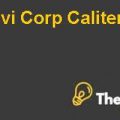LEVERAGE
The leverage ratios show that on average 2.4% of the company’s assets are financed through debt, however, the company is heavily financed by debt. In 2008, the capital structure of the company comprised of 86% debt and only 14% equity. The interest coverage ratio of the company is also satisfactory in 2008 standing at 76.4 times; however, it has also reduced over the previous five years. This might be due to the cash problems and the working capital management problems being faced by the company. But still the company has the highest interest coverage ratios as compared to the other PC manufacturers in the industry. The debt to equity ratio of Dell has slightly reduced from 2007 to 2008; this shows that the company has not been aggressive in financing its assets with debt.
MARKET RATIOS (VALUATION METRICS)
The share price as mentioned previously is on the decreasing trend for Dell. All other PC manufacturers’ share prices are increasing. However, the share price for Dell had decreased from $22.85 to $19.90 in 2008. The earnings per share of the company is average as compared to the other companies. However, the earning per share for Hewlett Packard is significantly higher in the PC industry. The price to earnings ratio for Dell had also decreased between 2007 and 2008. This became lower than the market average in S & P 500 in 2008. This shows that the future growth prospects of Dell are very poor. Apple and HP have the highest PE ratios in the industry. The market to book ratio for Dell is also very high and indicates the poor performance for Dell.
DELL’s STRATEGY AGAINST ITS COMPETITORS
Dell had competed against all of its competitors on the basis of its customer driven strategy. The main mission of Michael Dell was to sell more computers than any other PC manufacturer sold. The company had also focused on price to sell the cheapest computers than any other competitor and that they wanted to do without using any intermediary directly to the customers. The objective was to eliminate the middleman. The simple strategy which later proved to be the competitive advantage of Dell was that it first received the order from the customer, next it ordered the raw materials from the suppliers, the company then manufactured the customer’s product and finally it delivered the product to the customer. This proved to be a competitive advantage for Dell; this was the way through which Dell fared against its major competitors in the PC industry.
CONCLUSION/RECOMMENDED CHOICE FOR ANTHONY CHAN
Anthony Chan, who was the portfolio manager at Trinity Funds Incorporation, was reassessing his investment in Dell after the share price of the company had fallen. Looking at the performance of the company in 2007 and 2008, it would be recommended for Trinity Funds to sell his shares in Dell. The justification for this decision is that the financial performance of the company is deteriorating. The financial health of the company is also poor. The cash position is also deteriorating and the stock performance of Dell from 2003 to 2008 as compared to the competitors is very poor and the trend shows that it is decreasing. For a portfolio manager, the price of the stock and the future potential of that stock as shown by the PE ratio of the company is a significant factor. Therefore, based on these valuation metrics, it is recommended for Anthony Chan that he should sell his investment in Dell and consider another major player like Apple or Hewlett Packard that have great future growth prospects.............................
This is just a sample partial case solution. Please place the order on the website to order your own originally done case solution.












